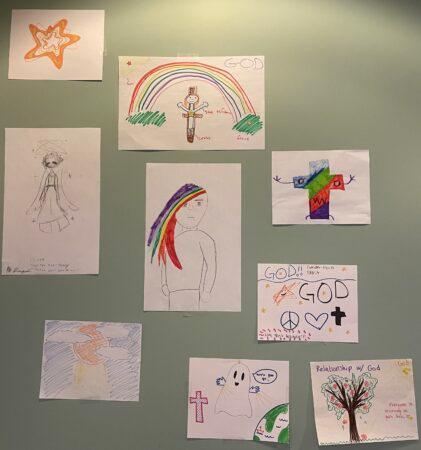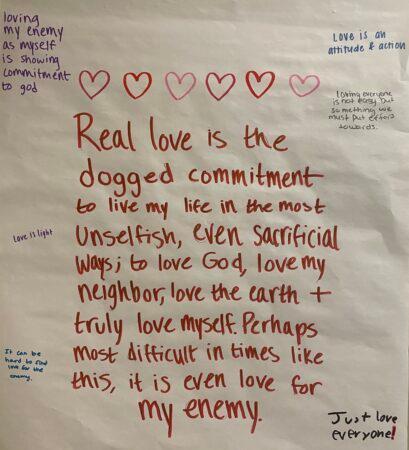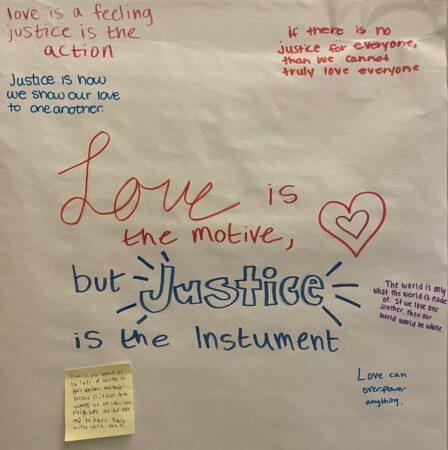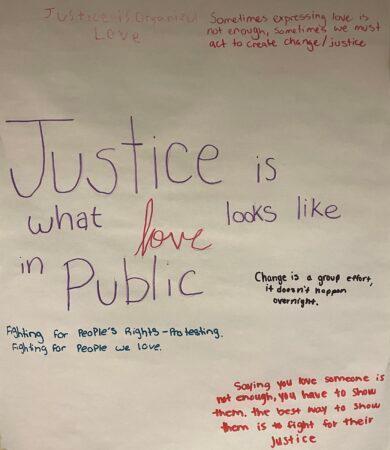For our Confirmation Retreat, I created a series of activities around the baptismal promises that invited movement, reflection, and conversation. We had already explored these promises in pre-retreat sessions; now it was time to play with them!
The Logistics
With 18 participants, it was important to explore and apply the promises in smaller groups. I set up five stations in adjoining spaces and divided the group evenly. Some stations were cooperative, while others were individual. Some required talking, or moving, or writing. Groups spent 10-15 minutes in each station.
Station 1: Rhythm of The Eucharist
“Will you continue in the apostles’ teaching and fellowship, in the breaking of the bread, and in the prayers?” (Book of Common Prayer, p. 304)
Directions: As a group, put the parts of the Eucharist in order. This is difficult! Ask for help if you need it.
Supplies: Printed cards with parts of the Eucharist (the adapted, i.e. easierversion)
In pre-retreat sessions we focused on fellowship and prayers, so it was time to explore the Eucharist. I also wanted a tactile, collaborative station where confirmands could teach each other.
This was the most frustrating station for my youth, and with good reason: the cards I provided were too detailed! Next time I do this activity, I will use modified cards that simplify the parts of the service.
What they did enjoy about this activity was its tactile nature and discovering how much they didn’t know they knew. For instance, many didn’t know what the Absolution was, but when they read an excerpt, they knew that it came after the Confession.
Station 2: Sin, Repentance, and Forgiveness
“Will you persevere in resisting evil, and, whenever you fall into sin, repent and return to the Lord?” (Book of Common Prayer, p. 304)
Directions: Individually, think of wrongs that you have committed against God or your neighbor. Think of things you’ve done or things you haven’t done that you should have. Write them on the sheets of paper provided. When you are ready, take them to the basin and silently ask God for forgiveness. Then put them in the basin and watch them dissolve: your sins are forgiven.
Supplies: Dissolving paper, basin with water, pens, vocabulary sheet: sin, reconciliation, repentance
Dissolving paper is a lovely way to demonstrate absolution. Sin is a serious topic, and so this activity made quiet space to reflect, repent, and receive God’s forgiveness.
I wasn’t sure how this activity would go, especially in the larger scope of a bustling, busy space. But time and again, I saw the participants in this group quietly writing, for longer than I expected, and then pausing for a good moment before placing their sheets in the water. I did need to change the water in the basin a few times, because the paper dissolves more quickly when the water is relatively clean. When I do this again, I might ask each group to get fresh water at the beginning of their time.
Station 3: Spiritual Gifts
“Will you proclaim by word and example the Good News of God in Christ?” (Book of Common Prayer, p. 305)
Directions: As a group, read the excerpt from Paul’s first letter to the Corinthians (1 Corinthians 12:4-11, 27-31). Then reflect on the questions together. Finally, add the spiritual gifts you come up with to the poster paper.
Supplies: Handout with questions, poster paper, markers
In pre-retreat sessions, this was the most difficult promise for my confirmands to comprehend. What does it look like to proclaim by word and example the Good News of God in Christ in a pluralistic society, when many of your friends are faithful non-Christians or skeptical about organized religion? We unpacked “Good News” and thought about God’s dream for humanity. We named the complicated history of Christian missionaries and looked to the story of Philip and the Ethiopian eunuch (Acts 8:26-38) as a possible model for sharing the Good News.
So instead of focusing on proclaiming by word, this retreat activity invites confirmands to think about how their gifts can help others feel God’s love and understand God’s dream for the world.

Confirmands seemed least engaged in this station, which (I believe) is a reflection of its reading-heavy format and relatively unfamiliar topic (spiritual gifts). It would work better as a lectio divina reading for the whole group. Next time, this station will be an art station, with magazines to cut up as well as markers and colored pencils. The prompt: How can I proclaim by word and example the Good News of God in Christ? Then we will put the artwork on our gallery wall.
Station 4: Loving Like Jesus, Loving Jesus in Others
“Will you seek and serve Christ in all persons, loving your neighbor as yourself?” (Book of Common Prayer, p. 305)
Directions: Jesus was really good at loving people, and especially good at loving people whom others thought were unworthy of love, community, and dignity. Take turns reading short stories about Jesus loving unlikely people, along with a brief question for each story.
Supplies: Bible story handouts/cards
My group cares about social justice issues, so grounding their civic and social outlook in the gospel of Jesus is imperative if we want them to connect to the baptismal covenant during the full length and breadth of their lives. Biblical literacy is always a good idea, and Jesus is our model for how to live a Christian life.
As I walked by and listened to the conversation at this station, I heard that each group was engaged and curious. Jesus does unexpected things and reaches out to unexpected people. Participants wondered about the stories. More than once I heard them connecting these stories of love, welcome, and healing to their own experiences in school, at home, and among their friends.
Station 5: Love, Justice, and Human Dignity
“Will you strive for justice and peace among all people, and respect the dignity of every human being?” (Book of Common Prayer, p. 305)
Directions: Read Presiding Bishop Michael Curry’s “Word to the Church” individually, and then reflect on the quotes on poster paper. You may respond to the quotes or ask questions about them. There is also a sheet to add new questions or thoughts that don’t fit under the questions provided.
Supplies: Bishop Curry’s “Word to the Church”, markers, poster paper with the following quotation written at the top:
Reinhold Niebuhr: “Love is the motive, but justice is the instrument.”
Cornel West: “Justice is what love looks like in public.”
Bishop Curry: “Real love is the dogged commitment to live my life in the most unselfish, even sacrificial ways; to love God, love my neighbor, love the earth and truly love myself. Perhaps most difficult in times like this, it is even love for my enemy.”
This group of confirmands tends towards social justice engagement and is critical of the church when the response to injustice is tepid. To connect their baptismal promises to what is happening in the world and to how their church leaders respond to brokenness and violence offers them a way of following Jesus that prioritizes justice and human dignity over “being nice.”
This station was quiet and heavy, but based on their reflections on the posterboard, it was fruitful time. Next time I will begin the station with a video rather than a written statement, for variety’s sake and to meet different learners where they are.
A Few Responses to Station 5:

“Loving my enemy as myself is showing commitment to God.”
“Love is an attitude and action.”
“Loving everyone is not easy but something we must put effort towards.”
“Just love everyone!”
“It can be hard to find love for the enemy.”

“Love is a feeling, justice is the action.“
“If there is no justice for everyone, then we cannot truly love everyone.”
“The world is only what the world is made of. If we love one another, then our world would be whole.”
“Love can overpower anything.”

“Justice is organized love.”
“Sometimes expressing love is not enough, sometimes we must act to create change/justice.“
“Change is a group effort, it doesn’t happen overnight.”
“Fighting for people’s rights, protesting, fighting for people we love.”
Featured photo by Joshua Eckstein on Unsplash.
